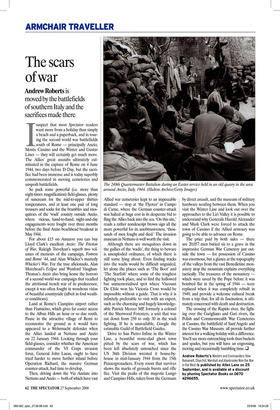The scars of war
Andrew Roberts is
moved by the battlefields of southern Italy and the sacrifices made there
Isuspect that most Spectator readers want more from a holiday than simply a beach and a paperback, and in touring the second world war battlefields south of Rome — principally Anzio, Monte Cassino and the Winter and Gustav Lines — they will certainly get much more. The Allies’ great assaults ultimately culminated in the capture of Rome on 4 June 1944, two days before D-Day, but the sacrifice had been immense and is today superbly commemorated in moving cemeteries and unspoilt battlefields.
So pack some powerful (i.e. more than eight-times magnification) field-glasses, plenty of suncream for the mid-to-upper thirties temperatures, and at least one pair of long trousers and socks for the brambles and mosquitoes of the ‘wadi’ country outside Anzio, where vicious, hand-to-hand, night-and-day engagements were fought over three months before the final Anzio beachhead breakout in May 1944.
For about £15 on Amazon you can buy Lloyd Clark’s excellent Anzio: The Friction of War, Raleigh Trevelyan’s superb two volumes of memoirs of the campaign, Fortress and Rome ’44, and Alan Whicker’s masterly Whicker’s War. For the true aficionado, Alan Morehead’s Eclipse and Wynford VaughanThomas’s Anzio also bring home the horrors of a second world war campaign that recalled the attritional trench war of its predecessor, except it was often fought in wondrous vistas of beautiful countryside (albeit in foul weather conditions).
Land at Rome’s Ciampino airport rather than Fiumicino, which gives far easier access to the Alban Hills an hour or so due south. Pause in the attractive village of Remi to reconnoitre the ground as it would have appeared to a Wehrmacht defender when the Allies landed at Nettuno and Anzio on 22 January 1944. Looking through your field-glasses, consider whether the American commander of the VI Corps invasion force, General John Lucas, ought to have tried harder to move further inland before Operation Richard, the massive German counter-attack, had time to develop.
Then, driving down the Via Anziate into Nettuno and Anzio — both of which have vast Allied war cemeteries kept to an impeccable standard — stop at ‘the Flyover’ in Campo di Carne, where the German counter-attack was halted at huge cost in its desperate bid to fling the Allies back into the sea. ‘On this site,’ reads a rather nondescript brown sign all the more powerful for its unobtrusiveness, ‘thousands of men fought and died.’ The invasion museum in Nettuno is well worth the visit.
Although there are mosquitoes down in the gullies of the ‘wadis’, the thing to beware is unexploded ordnance, of which there is still some lying about. Even finding tracks into the wadis would be difficult unguided, let alone the places such as ‘The Boot’ and ‘The Starfish’ where some of the toughest fighting took place, and to find the hallowed but unmemorialised spot where Viscount De L’Isle won his Victoria Cross would be impossible without a guide. That is why it is infinitely preferable to visit with an expert, such as the charming and hugely knowledgeable Patrick Mercer MP, formerly a colonel of the Sherwood Foresters, a unit that was cut down from 250 to only 30 in the wadi fighting. If he is unavailable, Google the estimable Guild of Battlefield Guides.
Drive to San Pietro Infine in the Winter Line, a beautiful stone-clad ghost town pitted by the scars of war, which has been left absolutely untouched since the US 36th Division wrested it house-byhouse in mid-January 1944 from the 15th Panzergrenadiers. Every room that survives shows the marks of grenade bursts and rifle fire. Visit the peaks of the majestic Lungo and Campino Hills, taken from the Germans by direct assault, and the museum of military hardware nestling between them. When you visit the Winter Line and look out over the approaches to the Liri Valley it is possible to understand why Generals Harold Alexander and Mark Clark were forced to attack the town of Cassino if the Allied armoury was going to be able to advance on Rome.
The price paid by both sides — there are 20,057 men buried six to a grave in the impressive German War Cemetery just outside the town — for possession of Cassino was enormous, but a glance at the topography of the valleys from the vast Benedictine monastery atop the mountain explains everything tactically. The treasures of the monastery — which were saved by the Pope before it was bombed flat in the spring of 1944 — were replaced when it was completely rebuilt in 1949, and provide a welcome cultural break from a trip that, for all its fascination, is ultimately concerned with death and destruction.
The crossing of the Rapido river, the fighting over the Garigliano and Gari rivers, the Polish and Commonwealth War Cemeteries at Cassino, the battlefield of Sant’Angelo and the Cassino War Museum: all provide further interest for a walking holiday with a difference. You’ll see more entrenching tools than buckets and spades, but you will have an engrossing, moving and occasionally humbling time. ❑
Andrew Roberts’s Masters and Commanders: How Roosevelt, Churchill, Marshall and Alanbrooke Won the War in the West is published by Allen Lane on 25 September, and is available at a discount by phoning Spectator Books on 0870 4296655.










































































 Previous page
Previous page